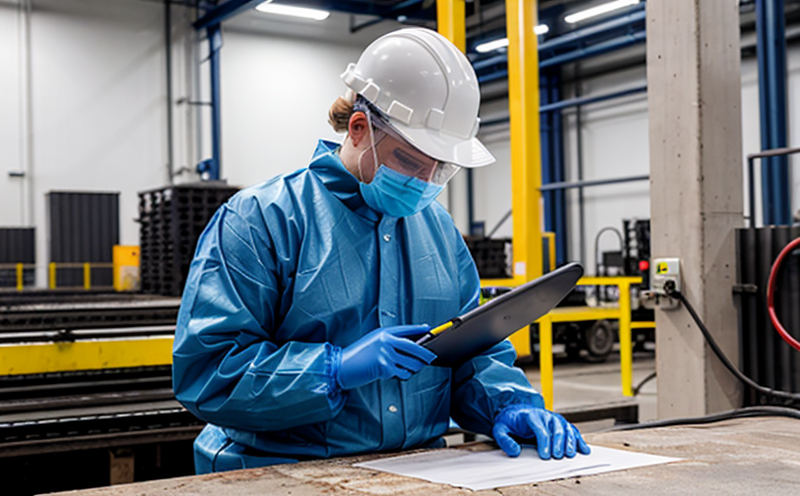ISO 17491 Protective Clothing Gas Tightness Testing Validation Method Development Test
The ISO 17491:2003 standard specifies a validation method to demonstrate the gas tightness of protective clothing. This service is essential for ensuring that workers in high-risk environments are adequately protected from hazardous gases and vapors. The testing process involves several critical steps, including specimen preparation, setup of the test apparatus, application of gas, measurement of pressure decay rates, and analysis of results.
The primary focus of this service is to develop a validated method that ensures protective clothing meets the stringent requirements set forth by ISO 17491. This involves not only conducting rigorous tests but also providing detailed validation reports that can be used for regulatory compliance purposes.
Specimen preparation is crucial as it directly impacts the accuracy of the test results. The specimens are typically cut from the actual protective clothing, ensuring that they accurately represent the material and design of the garment. The setup of the test apparatus includes connecting the specimen to a pressure chamber where gas can be introduced under controlled conditions.
The application of gas is a critical step in this process. The gas used for testing must be consistent with the hazards present in the workplace environment. Once the gas has been applied, it is important to measure the rate at which the pressure inside the specimen changes over time. This measurement provides an indication of how effectively the protective clothing retains the gas.
Analysis of the results involves comparing the measured pressure decay rates against predetermined acceptance criteria specified in ISO 17491. If the rates fall within acceptable limits, it can be concluded that the protective clothing is sufficiently gas tight. However, if they do not meet these criteria, further modifications may be necessary to improve the design or materials of the garment.
The entire process requires meticulous attention to detail and adherence to strict protocols outlined in ISO 17491. This ensures that the results are reliable and valid, providing confidence in the protective capabilities of the clothing.
| Test Parameter | Description |
|---|---|
| Gas Type | The type of gas used for testing should match the hazard present in the workplace environment. |
| Pressure Chamber | A sealed chamber where the specimen and gas are tested under controlled conditions. |
| Measurement Technique | An advanced pressure measurement device capable of accurately detecting changes in pressure within the specimen. |
| Acceptance Criteria | The standards defined by ISO 17491 for determining whether the protective clothing meets gas tightness requirements. |
In conclusion, this service is vital for ensuring the safety of workers in environments where exposure to hazardous gases and vapors is a risk. By following the rigorous protocols set forth by ISO 17491, we can provide accurate and reliable validation of protective clothing gas tightness.
Benefits
The benefits of this service extend beyond mere compliance with regulatory requirements; they also contribute significantly to enhancing workplace safety. By validating the gas tightness of protective clothing through ISO 17491, employers demonstrate their commitment to employee health and well-being.
- Enhanced Safety: Ensures that workers are protected from hazardous gases and vapors.
- Regulatory Compliance: Meets the stringent requirements set by international standards such as ISO 17491.
- Informed Decision-Making: Provides detailed validation reports that can be used for strategic planning and risk assessment.
- Improved Design: Identifies areas where improvements are necessary, leading to better garment design and materials selection.
- Increased Confidence: Ensures that protective clothing meets the highest standards of performance and reliability.
In addition to these tangible benefits, this service also fosters a culture of safety within organizations. It encourages continuous improvement in protective equipment and reinforces the importance of adhering to best practices in occupational health and safety.
Eurolab Advantages
Eurolab prides itself on offering comprehensive, high-quality testing services tailored to meet the unique needs of our clients. Our expertise in ISO 17491 protective clothing gas tightness testing is one example of how we go above and beyond to provide exceptional service.
- State-of-the-Art Facilities: Equipped with advanced testing equipment that ensures accurate and reliable results.
- Experienced Professionals: Our team comprises highly skilled and certified professionals who are experts in their field.
- Prompt Turnaround Times: We understand the importance of timely delivery, ensuring that you receive your reports as quickly as possible.
- Certified Compliance: Our services meet or exceed international standards such as ISO 17491 and ASTM D5208.
- Customized Solutions: We offer tailored testing solutions to address the specific requirements of your organization.
- Dedicated Support: Our clients receive personalized support throughout the entire process, from initial consultation to final report delivery.
At Eurolab, we are committed to helping our clients achieve their safety and compliance goals. By leveraging our expertise and resources, we can help you ensure that your workers are protected in even the most challenging environments.





